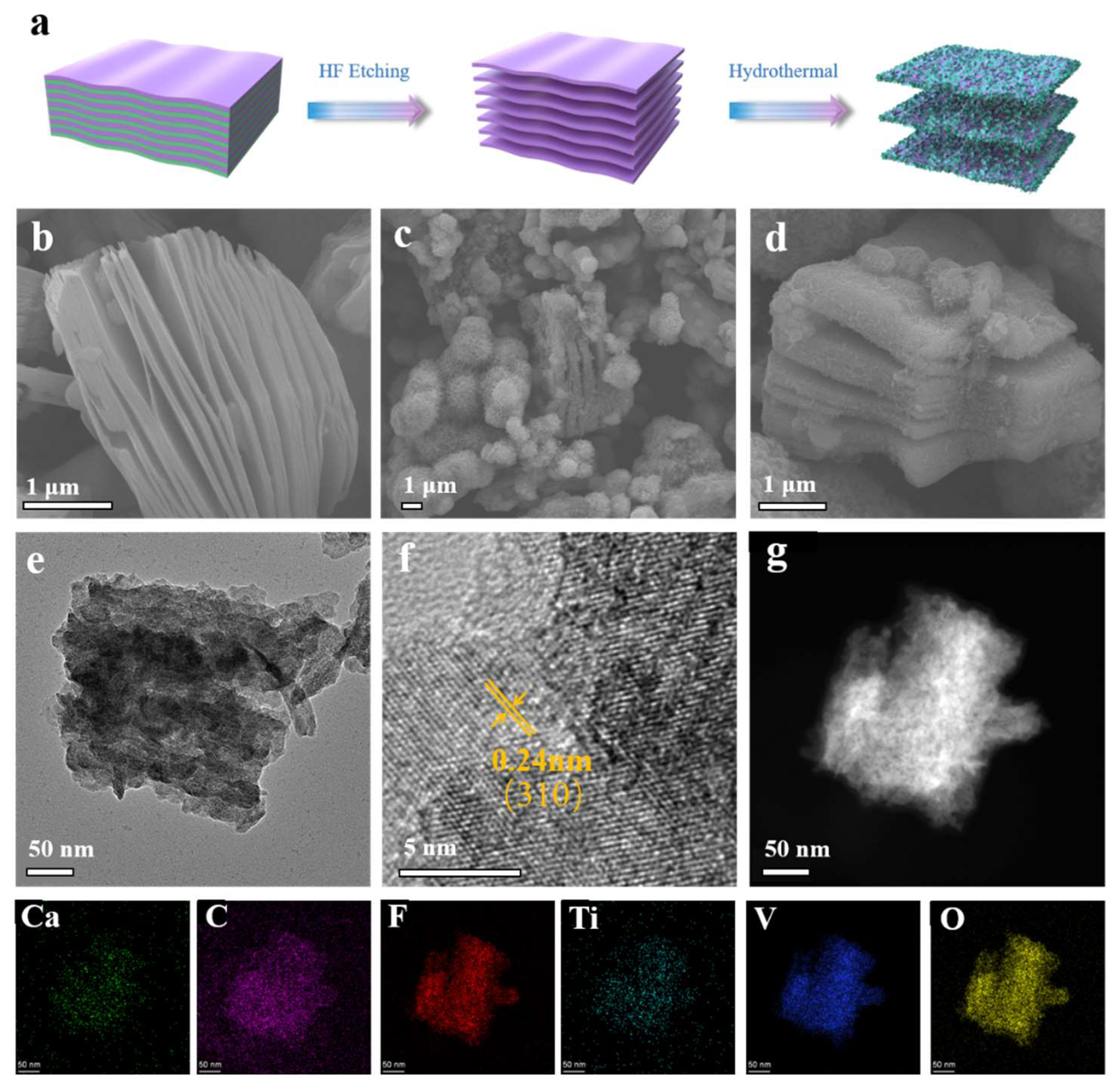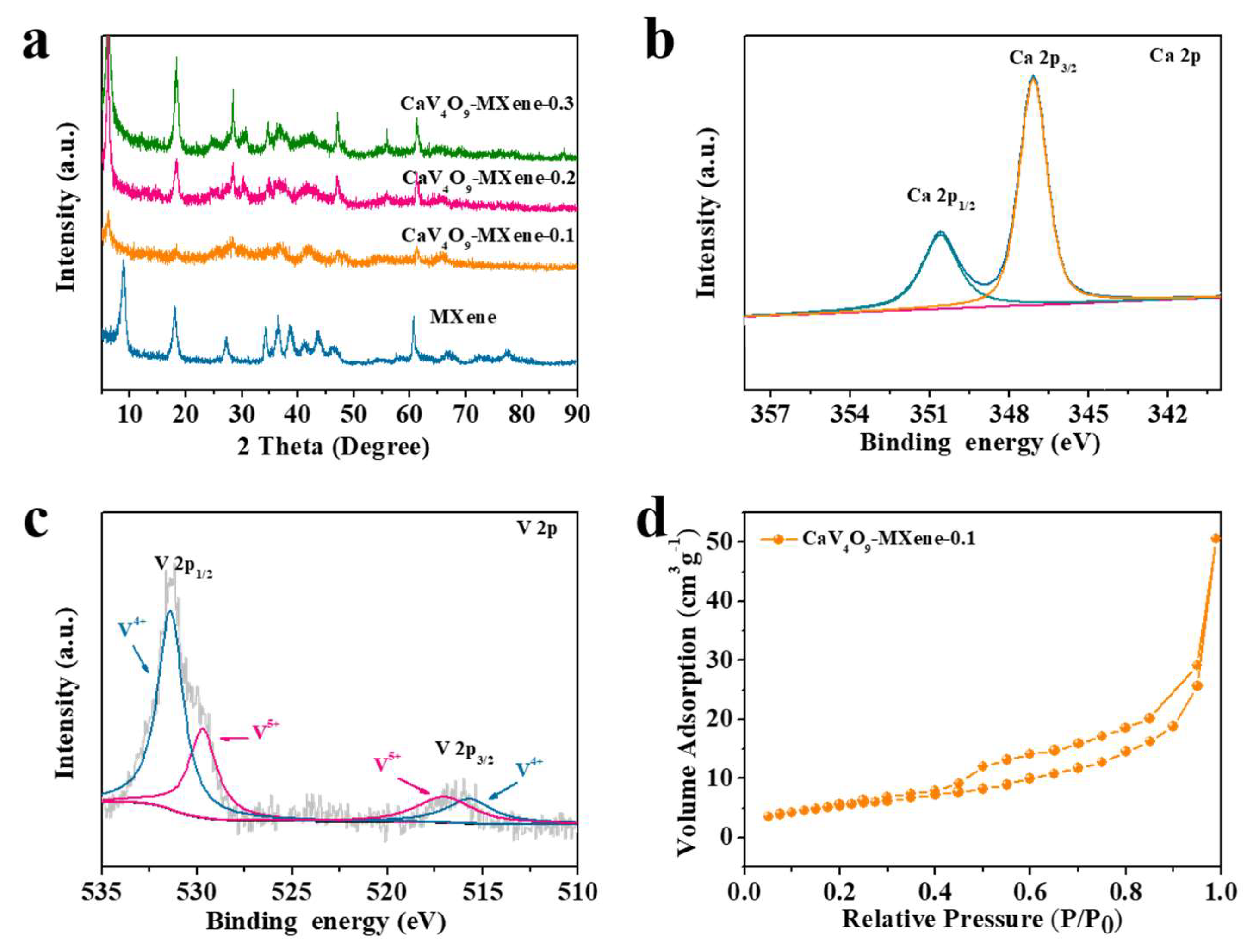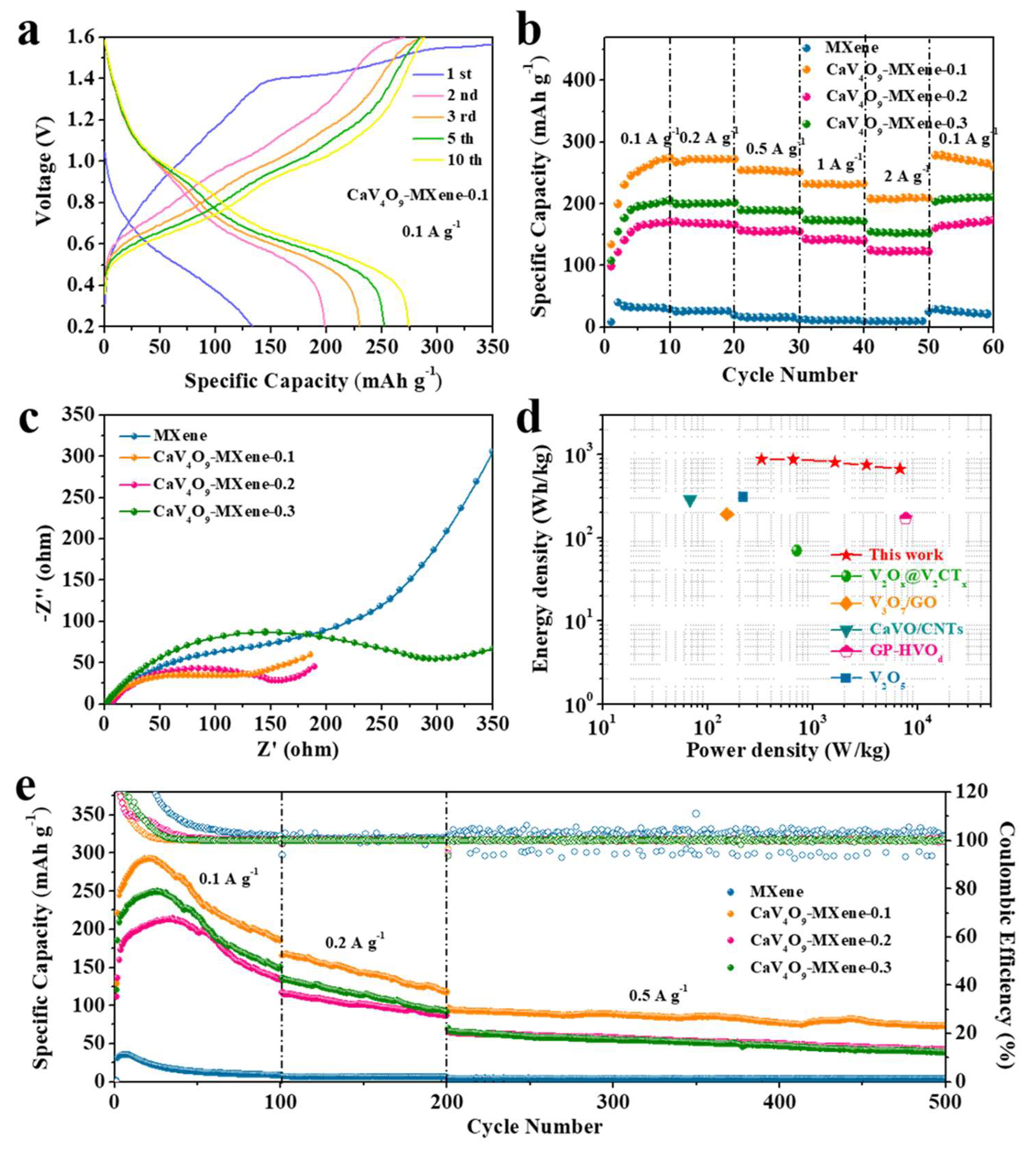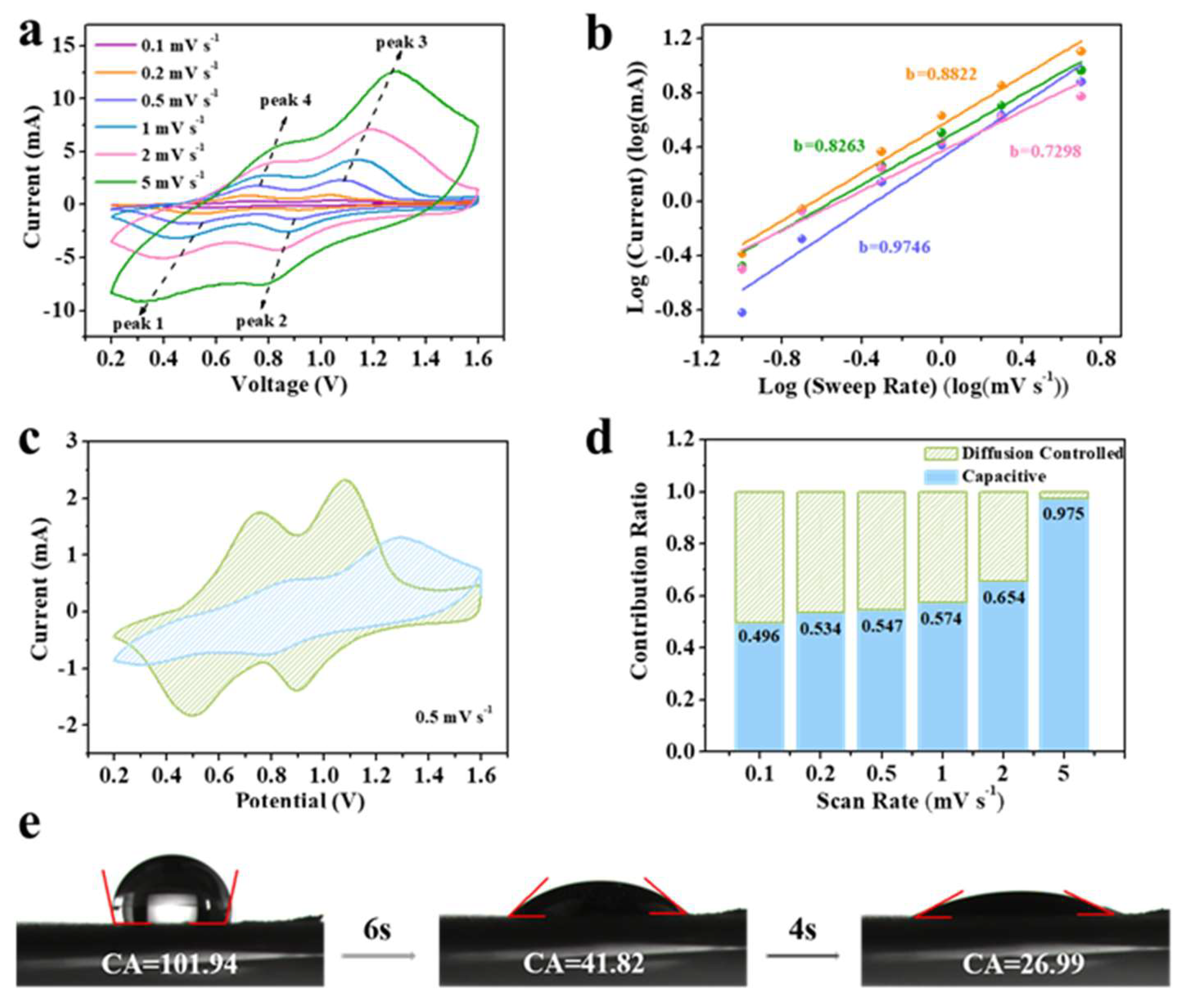High-Performance Layered CaV4O9-MXene Composite Cathodes for Aqueous Zinc Ion Batteries
Abstract
1. Introduction
2. Experimental Methods
2.1. Materials Synthesis
2.1.1. Synthesis of Ti3C2Tx MXene
2.1.2. Synthesis of CaV4O9-MXene
2.2. Characterizations
2.3. Electrochemical Measurements
3. Results and Discussion
3.1. Structure Characterization
3.2. Electrochemical Performance
3.3. Electrochemical Kinetics
4. Conclusions
Supplementary Materials
Author Contributions
Funding
Data Availability Statement
Conflicts of Interest
References
- Zhang, N.; Chen, X.; Yu, M.; Niu, Z.; Cheng, F.; Chen, J. Materials chemistry for rechargeable zinc-ion batteries. Chem. Soc. Rev. 2020, 49, 4203–4219. [Google Scholar] [CrossRef] [PubMed]
- Melief, C.J.M. Smart delivery of vaccines. Nat. Mater. 2018, 17, 482–483. [Google Scholar] [CrossRef] [PubMed]
- Li, S.; Wang, K.; Zhang, G.; Li, S.; Xu, Y.; Zhang, X.; Zhang, X.; Zheng, S.; Sun, X.; Ma, Y. Fast Charging Anode Materials for Lithium-Ion Batteries: Current Status and Perspectives. Adv. Funct. Mater. 2022, 32, 2200796. [Google Scholar] [CrossRef]
- Wang, Z.; Zhao, H.; Zhou, B.; Li, J.; Qi, Y.; Liang, K.; Zhao, Q.; Ding, Z.; Ren, Y. In Situ Surface Coating and Oxygen Vacancy Dual Strategy Endowing a Li-Rich Li1.2Mn0.55Ni0.11Co0.14O2 Cathode with Superior Lithium Storage Performance. ACS Appl. Energy Mater. 2023, 6, 387–396. [Google Scholar] [CrossRef]
- Li, C.; Jin, S.; Archer, L.A.; Nazar, L.F. Toward practical aqueous zinc-ion batteries for electrochemical energy storage. Joule 2022, 6, 1733–1738. [Google Scholar] [CrossRef]
- Li, X.; Chen, Z.; Yang, Y.; Liang, S.; Lu, B.; Zhou, J. The phosphate cathodes for aqueous zinc-ion batteries. Inorg. Chem. Front. 2022, 9, 3986–3998. [Google Scholar] [CrossRef]
- Zampardi, G.; La Mantia, F. Open challenges and good experimental practices in the research field of aqueous Zn-ion batteries. Nat. Commun. 2022, 13, 687. [Google Scholar] [CrossRef]
- Ming, J.; Guo, J.; Xia, C.; Wang, W.; Alshareef, H.N. Zinc-ion batteries: Materials, mechanisms, and applications. Mater. Sci. Eng. R Rep. 2019, 135, 58–84. [Google Scholar] [CrossRef]
- Zhang, Y.; Wan, F.; Huang, S.; Wang, S.; Niu, Z.; Chen, J. A chemically self-charging aqueous zinc-ion battery. Nat. Commun. 2020, 11, 2199. [Google Scholar] [CrossRef]
- Fang, G.; Zhou, J.; Pan, A.; Liang, S. Recent Advances in Aqueous Zinc-Ion Batteries. ACS Energy Lett. 2018, 3, 2480–2501. [Google Scholar] [CrossRef]
- Cui, H.; Wang, T.; Huang, Z.; Liang, G.; Chen, Z.; Chen, A.; Wang, D.; Yang, Q.; Hong, H.; Fan, J.; et al. High-Voltage Organic Cathodes for Zinc-Ion Batteries through Electron Cloud and Solvation Structure Regulation. Angew. Chem. Int. Ed. 2022, 61, e202203453. [Google Scholar] [CrossRef] [PubMed]
- Zhang, Y.; Tao, L.; Xie, C.; Wang, D.; Zou, Y.; Chen, R.; Wang, Y.; Jia, C.; Wang, S. Defect Engineering on Electrode Materials for Rechargeable Batteries. Adv. Mater. 2020, 32, e1905923. [Google Scholar] [CrossRef]
- Yang, J.; Yin, B.; Sun, Y.; Pan, H.; Sun, W.; Jia, B.; Zhang, S.; Ma, T. Zinc Anode for Mild Aqueous Zinc-Ion Batteries: Challenges, Strategies, and Perspectives. Nano-Micro Lett. 2022, 14, 42. [Google Scholar] [CrossRef]
- Pam, M.E.; Yan, D.; Yu, J.; Fang, D.; Guo, L.; Li, X.L.; Li, T.C.; Lu, X.; Ang, L.K.; Amal, R.; et al. Microstructural Engineering of Cathode Materials for Advanced Zinc-Ion Aqueous Batteries. Adv. Sci. 2020, 8, 2002722. [Google Scholar] [CrossRef] [PubMed]
- Wang, T.; Li, C.; Xie, X.; Lu, B.; He, Z.; Liang, S.; Zhou, J. Anode Materials for Aqueous Zinc Ion Batteries: Mechanisms, Properties, and Perspectives. ACS Nano 2020, 14, 16321–16347. [Google Scholar] [CrossRef] [PubMed]
- Zhang, M.; Liang, R.; Or, T.; Deng, Y.-P.; Yu, A.; Chen, Z. Recent Progress on High-Performance Cathode Materials for Zinc-Ion Batteries. Small Struct. 2020, 2, 2000064. [Google Scholar] [CrossRef]
- Dong, H.; Li, J.; Guo, J.; Lai, F.; Zhao, F.; Jiao, Y.; Brett, D.J.L.; Liu, T.; He, G.; Parkin, I.P. Insights on Flexible Zinc-Ion Batteries from Lab Research to Commercialization. Adv. Mater. 2021, 33, e2007548. [Google Scholar] [CrossRef]
- Wang, X.; Zhang, Z.; Xi, B.; Chen, W.; Jia, Y.; Feng, J.; Xiong, S. Advances and Perspectives of Cathode Storage Chemistry in Aqueous Zinc-Ion Batteries. ACS Nano 2021, 15, 9244–9272. [Google Scholar] [CrossRef]
- Shang, Y.; Kundu, D. A path forward for the translational development of aqueous zinc-ion batteries. Joule 2023, 7, 244–250. [Google Scholar] [CrossRef]
- Wang, L.; Cao, X.; Xu, L.; Chen, J.; Zheng, J. Transformed Akhtenskite MnO2 from Mn3O4 as Cathode for a Rechargeable Aqueous Zinc Ion Battery. ACS Sustain. Chem. Eng. 2018, 6, 16055–16063. [Google Scholar] [CrossRef]
- Ding, Y.; Xue, W.; Chen, K.; Yang, C.; Feng, Q.; Zheng, D.; Xu, W.; Wang, F.; Lu, X. Sodium Ion Pre-Intercalation of delta-MnO2 Nanosheets for High Energy Density Aqueous Zinc-Ion Batteries. Nanomaterials 2023, 13, 1075. [Google Scholar] [CrossRef]
- Zhao, S.; Tian, G.; Zhang, D.; Wang, Q. Controlled Synthesis of Metal–Organic-Framework-Derived V2O5 Nanostructures with Polypyrrole Coating for Zinc-Ion Batteries. ACS Appl. Nano Mater. 2023, 6, 1849–1858. [Google Scholar] [CrossRef]
- Tan, S.; Sang, Z.; Yi, Z.; Guo, J.; Zhang, X.; Li, P.; Si, W.; Liang, J.; Hou, F. Conductive coating, cation-intercalation, and oxygen vacancies co-modified vanadium oxides as high-rate and stable cathodes for aqueous zinc-ion batteries. EcoMat 2023, 5, e12326. [Google Scholar] [CrossRef]
- Guan, H.; Feng, Y. Preparation of ultrathin two-dimensional CaV4O9 nanosheets: A new inorganic graphene-like material. Mater. Lett. 2014, 131, 222–224. [Google Scholar] [CrossRef]
- Chen, Y.; Ma, D.; Shen, S.; Deng, P.; Zhao, Z.; Yang, M.; Wang, Y.; Mi, H.; Zhang, P. New insights into high-rate and super-stable aqueous zinc-ion batteries via the design concept of voltage and solvation environment coordinated control. Energy Stor. Mater. 2023, 56, 600–610. [Google Scholar] [CrossRef]
- Li, Z.; Wei, Y.; Liu, Y.; Yan, S.; Wu, M. Dual Strategies of Metal Preintercalation and In Situ Electrochemical Oxidization Operating on MXene for Enhancement of Ion/Electron Transfer and Zinc-Ion Storage Capacity in Aqueous Zinc-Ion Batteries. Adv. Sci. 2023, 10, e2206860. [Google Scholar] [CrossRef] [PubMed]
- Wu, P.; Xu, X.; Wu, Y.; Xu, F.; Wang, X.; Meng, J.; Han, C.; Liu, X.; Zhu, Z.; Mai, L. A Stable CaV4O9 Anode Promises Near-Zero Volume Change and High-Capacity Lithium Storage. Adv. Energy Mater. 2021, 11, 2003612. [Google Scholar] [CrossRef]
- Xu, X.; Niu, C.; Duan, M.; Wang, X.; Huang, L.; Wang, J.; Pu, L.; Ren, W.; Shi, C.; Meng, J.; et al. Alkaline earth metal vanadates as sodium-ion battery anodes. Nat. Commun. 2017, 8, 460. [Google Scholar] [CrossRef]
- Du, Y.; Wang, X.; Zhang, Y.; Zhang, H.; Man, J.; Liu, K.; Sun, J. High mass loading CaV4O9 microflowers with amorphous phase transformation as cathode for aqueous zinc-ion battery. Chem. Eng. J. 2022, 434, 134642. [Google Scholar] [CrossRef]
- Li, J.; Hong, N.; Luo, N.; Dong, H.; Kang, L.; Peng, Z.; Jia, G.; Chai, G.; Wang, M.; He, G. In-situ electrochemical modification of pre-intercalated vanadium bronze cathodes for aqueous zinc-ion batteries. Sci. China Mater. 2022, 65, 1165–1175. [Google Scholar] [CrossRef]
- Wu, Q.; Li, X.; Fan, H.; Cao, J.; Liu, X.; Wei, M.; Yang, L. Synergistic interlayer and structure engineering construction of layered hydrated vanadates/graphene for stable aqueous zinc-ion batteries. J. Alloys Compd. 2023, 941, 168936. [Google Scholar] [CrossRef]
- Zhu, X.; Cao, Z.; Wang, W.; Li, H.; Dong, J.; Gao, S.; Xu, D.; Li, L.; Shen, J.; Ye, M. Superior-Performance Aqueous Zinc-Ion Batteries Based on the In Situ Growth of MnO2 Nanosheets on V2CTX MXene. ACS Nano 2021, 15, 2971–2983. [Google Scholar] [CrossRef]
- Shi, M.; Wang, B.; Shen, Y.; Jiang, J.; Zhu, W.; Su, Y.; Narayanasamy, M.; Angaiah, S.; Yan, C.; Peng, Q. 3D assembly of MXene-stabilized spinel ZnMn2O4 for highly durable aqueous zinc-ion batteries. Chem. Eng. J. 2020, 399, 125627. [Google Scholar] [CrossRef]
- Venkatkarthick, R.; Rodthongkum, N.; Zhang, X.; Wang, S.; Pattananuwat, P.; Zhao, Y.; Liu, R.; Qin, J. Vanadium-Based Oxide on Two-Dimensional Vanadium Carbide MXene (V2Ox@V2CTx) as Cathode for Rechargeable Aqueous Zinc-Ion Batteries. ACS Appl. Energy Mater. 2020, 3, 4677–4689. [Google Scholar] [CrossRef]
- Narayanasamy, M.; Kirubasankar, B.; Shi, M.; Velayutham, S.; Wang, B.; Angaiah, S.; Yan, C. Morphology restrained growth of V(2)O(5) by the oxidation of V-MXenes as a fast diffusion controlled cathode material for aqueous zinc ion batteries. Chem. Comm. 2020, 56, 6412–6415. [Google Scholar] [CrossRef] [PubMed]
- Zhu, K.; Wu, T.; Huang, K. A High Capacity Bilayer Cathode for Aqueous Zn-Ion Batteries. ACS Nano 2019, 13, 14447–14458. [Google Scholar] [CrossRef]
- Wu, F.; Wang, Y.; Dai, X.; Meng, S.; Zheng, D.; Yin, R.; Liu, W.; Shi, W.; Cao, X. Toward Ultralong Lifespan Aqueous Zinc-Ion Batteries via Sulfur-Defect Vanadium Tetrasulfide Cathode. ACS Appl. Energy Mater. 2023, 6, 2680–2686. [Google Scholar] [CrossRef]
- Liu, M.; Chang, L.; Wang, J.; Li, J.; Jiang, J.; Pang, G.; Wang, H.; Nie, P.; Zhao, C.; Xu, T.; et al. Hierarchical N-doped carbon nanosheets submicrospheres enable superior electrochemical properties for potassium ion capacitors. J. Power Sources 2020, 469, 228415. [Google Scholar] [CrossRef]
- Huang, Z.; Chen, A.; Mo, F.; Liang, G.; Li, X.; Yang, Q.; Guo, Y.; Chen, Z.; Li, Q.; Dong, B.; et al. Phosphorene as Cathode Material for High-Voltage, Anti-Self-Discharge Zinc Ion Hybrid Capacitors. Adv. Energy Mater. 2020, 10, 2001024. [Google Scholar] [CrossRef]
- Wang, Z.; Song, Y.; Wang, J.; Lin, Y.; Meng, J.; Cui, W.; Liu, X.X. Vanadium Oxides with Amorphous-Crystalline Heterointerface Network for Aqueous Zinc-Ion Batteries. Angew. Chem. Int. Ed. 2023, 62, e202216290. [Google Scholar] [CrossRef]
- Tian, C.-Y.; Li, Y.-D.; Du, D.-N.; Zhang, Y.-S.; Zhang, B.-M.; Zhang, D.-T.; Kong, L.-B.; Liu, M.-C. Hydrothermal reaction induced phase transition of vanadium oxide towards high-performance zinc ion batteries cathode. Ionics 2021, 27, 4793–4800. [Google Scholar] [CrossRef]
- Huang, J.; Liang, H.; Tang, Y.; Lu, B.; Zhou, J.; Liang, S. In Situ Induced Coordination between a “Desiccant” Interphase and Oxygen-Deficient Navajoite towards Highly Efficient Zinc Ion Storage. Adv. Energy Mater. 2022, 12, 2201434. [Google Scholar] [CrossRef]
- Li, X.; Li, M.; Yang, Q.; Liang, G.; Huang, Z.; Ma, L.; Wang, D.; Mo, F.; Dong, B.; Huang, Q.; et al. In Situ Electrochemical Synthesis of MXenes without Acid/Alkali Usage in/for an Aqueous Zinc Ion Battery. Adv. Energy Mater. 2020, 10, 2001791. [Google Scholar] [CrossRef]
- Zong, Q.; Wu, Y.; Liu, C.; Wang, Q.; Zhuang, Y.; Wang, J.; Tao, D.; Zhang, Q.; Cao, G. Tailoring layered transition metal compounds for high-performance aqueous zinc-ion batteries. Energy Stor. Mater. 2022, 52, 250–283. [Google Scholar] [CrossRef]
- Li, S.; Liu, Y.; Zhao, X.; Shen, Q.; Zhao, W.; Tan, Q.; Zhang, N.; Li, P.; Jiao, L.; Qu, X. Sandwich-Like Heterostructures of MoS2 /Graphene with Enlarged Interlayer Spacing and Enhanced Hydrophilicity as High-Performance Cathodes for Aqueous Zinc-Ion Batteries. Adv. Mater. 2021, 33, e2007480. [Google Scholar] [CrossRef] [PubMed]
- Jing, P.; Wei, W.; Luo, W.; Li, X.; Xu, F.; Li, H.; Wei, M.; Yu, D.; Zhu, Q.; Liu, G. In-situ XRD study of the structure and electrochemical performance of V2O5 nanosheets in aqueous zinc ion batteries. Inorg. Chem. Commun. 2020, 117, 107953. [Google Scholar] [CrossRef]
- He, P.; Yan, M.; Zhang, G.; Sun, R.; Chen, L.; An, Q.; Mai, L. Layered VS2 Nanosheet-Based Aqueous Zn Ion Battery Cathode. Adv. Energy Mater. 2017, 7, 1601920. [Google Scholar] [CrossRef]
- Xu, G.; Zhang, Y.; Gong, Z.; Lu, T.; Pan, L. Three-dimensional hydrated vanadium pentoxide/MXene composite for high-rate zinc-ion batteries. J. Colloid Interface Sci. 2021, 593, 417–423. [Google Scholar] [CrossRef]
- Xia, C.; Guo, J.; Li, P.; Zhang, X.; Alshareef, H.N. Highly Stable Aqueous Zinc-Ion Storage Using a Layered Calcium Vanadium Oxide Bronze Cathode. Angew. Chem. Int. Ed. 2018, 57, 3943–3948. [Google Scholar] [CrossRef]
- Yang, G.; Wei, T.; Wang, C. Self-Healing Lamellar Structure Boosts Highly Stable Zinc-Storage Property of Bilayered Vanadium Oxides. ACS Appl. Mater. Interfaces 2018, 10, 35079–35089. [Google Scholar] [CrossRef]
- Hu, P.; Yan, M.; Zhu, T.; Wang, X.; Wei, X.; Li, J.; Zhou, L.; Li, Z.; Chen, L.; Mai, L. Zn/V2O5 Aqueous Hybrid-Ion Battery with High Voltage Platform and Long Cycle Life. ACS Appl. Mater. Interfaces 2017, 9, 42717–42722. [Google Scholar] [CrossRef] [PubMed]
- Ming, F.; Liang, H.; Lei, Y.; Kandambeth, S.; Eddaoudi, M.; Alshareef, H.N. Layered MgxV2O5·nH2O as Cathode Material for High-Performance Aqueous Zinc Ion Batteries. ACS Energy Lett. 2018, 3, 2602–2609. [Google Scholar] [CrossRef]
- Park, J.-S.; Jo, J.H.; Aniskevich, Y.; Bakavets, A.; Ragoisha, G.; Streltsov, E.; Kim, J.; Myung, S.-T. Open-Structured Vanadium Dioxide as an Intercalation Host for Zn Ions: Investigation by First-Principles Calculation and Experiments. Chem. Mater. 2018, 30, 6777–6787. [Google Scholar] [CrossRef]





Disclaimer/Publisher’s Note: The statements, opinions and data contained in all publications are solely those of the individual author(s) and contributor(s) and not of MDPI and/or the editor(s). MDPI and/or the editor(s) disclaim responsibility for any injury to people or property resulting from any ideas, methods, instructions or products referred to in the content. |
© 2023 by the authors. Licensee MDPI, Basel, Switzerland. This article is an open access article distributed under the terms and conditions of the Creative Commons Attribution (CC BY) license (https://creativecommons.org/licenses/by/4.0/).
Share and Cite
Fang, L.; Lin, L.; Wu, Z.; Xu, T.; Wang, X.; Chang, L.; Nie, P. High-Performance Layered CaV4O9-MXene Composite Cathodes for Aqueous Zinc Ion Batteries. Nanomaterials 2023, 13, 1536. https://doi.org/10.3390/nano13091536
Fang L, Lin L, Wu Z, Xu T, Wang X, Chang L, Nie P. High-Performance Layered CaV4O9-MXene Composite Cathodes for Aqueous Zinc Ion Batteries. Nanomaterials. 2023; 13(9):1536. https://doi.org/10.3390/nano13091536
Chicago/Turabian StyleFang, Luan, Li Lin, Zhuomei Wu, Tianhao Xu, Xuxu Wang, Limin Chang, and Ping Nie. 2023. "High-Performance Layered CaV4O9-MXene Composite Cathodes for Aqueous Zinc Ion Batteries" Nanomaterials 13, no. 9: 1536. https://doi.org/10.3390/nano13091536
APA StyleFang, L., Lin, L., Wu, Z., Xu, T., Wang, X., Chang, L., & Nie, P. (2023). High-Performance Layered CaV4O9-MXene Composite Cathodes for Aqueous Zinc Ion Batteries. Nanomaterials, 13(9), 1536. https://doi.org/10.3390/nano13091536




